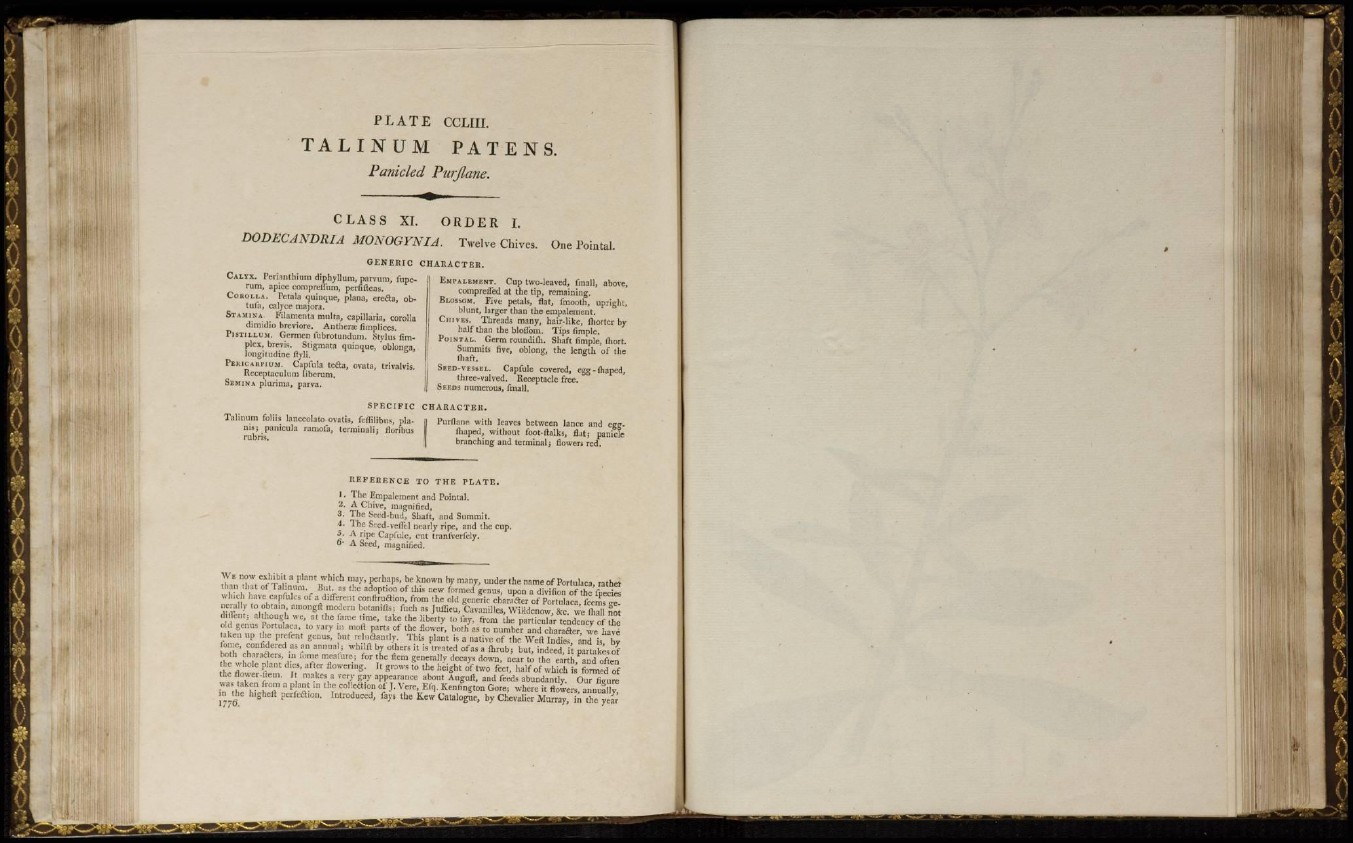
T A L I N U M P A T E N S.
Panicled Purßane.
CLASS XI. ORDER I.
DODECANDRIA MONOGYNIA. Twelve Chives. One Pointai.
G E N E R I C CHARACTER.
C A L Y X . Perianthium diphyllum, parvum, fuper
u m , ápice comprcHiun, perfiflens.
C O R O L L A . Pétala q u i n q u é , plana, erecta, obtufa,
calyce majora.
S T A M I N A Filamenta m u l t a , capillaria, corolla
dimidio breviore. Antberae fimplices.
P I S T I L L U M . Germen fubrotundum. Stylus fimplex,
brevis. Stigmata quinqué, oblonga
l o n g i t u d i n e ífyli.
P E R I C A R P I U M . Capfula tecia, ovata, trivalvis.
Receptaculum libemm.
S E M I N A p l u r i m a , parva.
E M P A L E M E N T . Cup two-leaved, imall, above,
comprefled at t h e t i p , remaining.
BLOSSOM. Five petals, flat, fmooth, upright,
b l u n t , larger than the empalement.
C H I V E S . Threads many, bair-like, fhorter by
half than the bloifom. Tips Ample.
P O I N T A L . Germ roundifli. Shaft Ample, ihort.
Summits five, oblong, the length of the
iliaft.
SEED-VESBEL. Capfule covered, e g g - i h a p e d,
tbree-valved. Receptacle free.
SEEDS numerous, fmail.
S P E C I F I C CHARACTER.
T a l i n um foliis lanceolato ovatis, feffilibns, plañ
í s ; panícula ramofa, terminali; floribus
r u b r i s .
Purflane with leaves between lance and eggihaped,
without foot-ftalks, flat; panicle
branching and t e r m i n a l ; flowers red.
REFERENCE TO THE PLATE.
1. The Empalement and Pointal.
2. A Chive, magnified,
3. T h e Seed-bud, Shaft, and Summit.
•i. The Sred-vefiel nearly ripe, and the cup.
5. A ripe Capfule, cut tranfverfely.
0' A Seed, magnified.
WE now exhibit a plant w h i c h may, perhaps, be k n o w n by many, under t h e name of Portnlaca, rather
t h a n that of T a l i n u m . But. as t h e adoption of this new formed gr-nus, upon a divilion of t h e fpecies
which have capfuhs of a different con it ruction, from ihe old generic c h a n c i e r of Portnlaca, fcems gen
e r a l l y t o o b t a i n , amongit modern botanifls; fuch as Juflieu, Cavanilles, WiHdenow, &c. w e fhall not
d i i l e n t ; although we, at the fame time, take the l i b e r t y to fay. from the particular tendency of the
old genus Portulaca, to vary in moil parts of the flower, both as t o n u m b e r and character, we have
t a k e n up the prefeot genus, bat reluctantly. This plant is a native of the Weft Indie*, and is, by
fome, confidercd as an a n n u a l ; whilft by others it is treated of as a f h r u b ; but, indeed, it p a r t a k e s of
both characters, in fome meal'urc; for t h e item generally decays down, near to the earth, and often
t h e whole plant dies, after flowering. It gr;>ws t o t h e height of t w o feet, half of which is formed of
t h e flower.iiem. It makes a very gav appearance about A u g u i t , a n d feeds a b u n d a n t l y . Our figure
was taken from a plant in the collection of J . Yerc, Elq. Kentington Gore; where it flowers, annually,
i n t h e higheft perfection. Introduced, fays t h e K e w Catalogue, by Chevalier M u r r a y , in the year
1776.